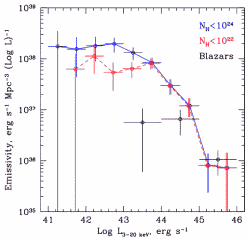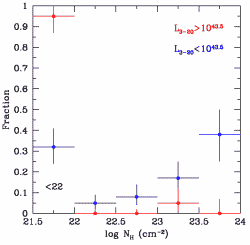

Fig. 3:
Distribution of X-ray volume emissivity between AGNs of various luminosities and absorption columns.
|
|
 |


Fig. 4:
Intrinsic absorption distribution of low and high luminosity AGNs.
|
|
|
 |
At energies higher than 2-5 keV the X-ray illumination of Earth
is dominated by tens of millions of extragalactic sources that make up
the Cosmic X-ray Background (CXB). The main contributors to the CXB
are active galactic nuclei (AGNs). AGNs fill almost the entire volume
of the Universe, approximately tracing the matter density
distribution. Deep surveys such as those performed recently with the
CHANDRA and XMM-Newton observatories can efficiently probe the distant
Universe (out to a redshift ~4), but tell us very little about our local
environment because such surveys cover only a tiny fraction of the
sky. In order to study the local population of extragalactic
sources all-sky surveys are needed. The last such survey at energies
above >2 keV was carried out more than 20 years ago by the HEAO 1
observatory. With the help of the RXTE observatory researchers at
the Max-Planck Institute for Astrophysics have now performed a new
all-sky X-ray survey.
The RXTE observatory (Fig.1) was launched at the end of 1995 and has
been successfully operating in orbit since then. Its main instruments
PCA and HEXTE are collimated spectrometers designed to observe X-ray
point sources while the observatory is oriented toward them. We took
advantage of the excellent calibration, moderate field of view (1
deg radius) and high effective area (~6400 sq. cm) of the PCA
instrument to construct a map of the whole sky in the 3-20 keV band (Fig. 2)
from the data accumulated during reorientations (slews) of the
observatory from one target to another.
During the period 1996-2003 slew observations covered almost the whole sky
with a total exposure of ~20 million sec. For most of the sky a
flux limit of 0.9 mCrab (2-10 keV) or better has been achieved,
which is better than and comparable to that of the HEAO1/A2 and
HEAO1/A1 surveys, respectively. In addition, approximately 20% of the
sky have been covered with a much higher sensitivity of 0.3
mCrab. Furthemore, our survey extends into the energy range 10-20
keV, surpassing by an order of magnitude the sensitivity of the
previous hard X-ray survey done with the HEAO 1/A4 experiment.
As a result of the analysis of the all-sky map, a total of 294 X-ray
sources have been detected and localized to better than 1 deg. 236 of
them can be confidently associated with a single known astrophysical
object, including 63 sources located within the Milky Way, LMC or SMC, 64
clusters of galaxies and 100 AGNs. 35 of the detected sources remain
unidentified, and because their observed X-ray spectra are hard we
believe that many of them are AGNs, including highly
obscured ones undetectable by soft X-ray telescopes.
Using the sample of detected sources, we have constructed the
best-to-date X-ray luminosity function of local (at redshift below
0.1) AGNs. It turns out that relatively weak AGNs with a large degree of
circumnuclear obscuration, which were largely missed by previous
all-sky surveys, dominate in the X-ray output of the local Universe
(Fig.3). In addition to that our analysis has revealed that the ratio
of obscured objects to unobscured ones strongly changes with the AGN
luminosity, from 2:1 for low-luminosity AGNs (L_X < 10^43.5 erg/s) to
less than 1:5 for high-luminosity ones. This behavior is illustrated in
Fig. 4.
Mikhail Revnivtsev, Sergey Sazonov, Marat Gilfanov
References:
Revnivtsev M., Sazonov S., Jahoda K., Gilfanov M. 2004, A&A submitted
Sazonov S., Revnivtsev M. 2004, A&A submitted
|
